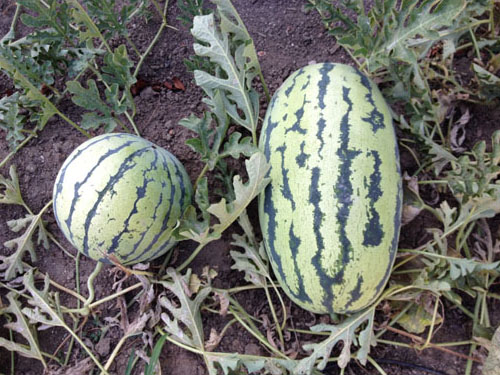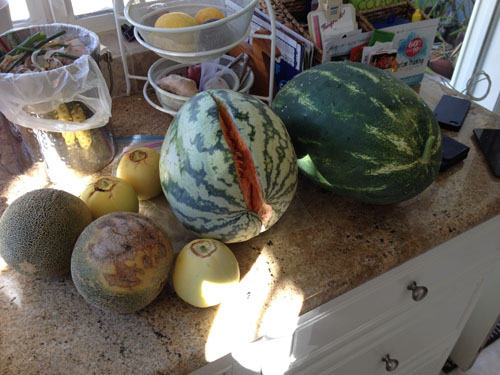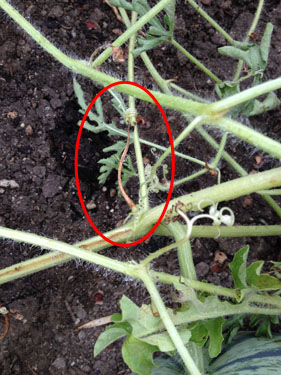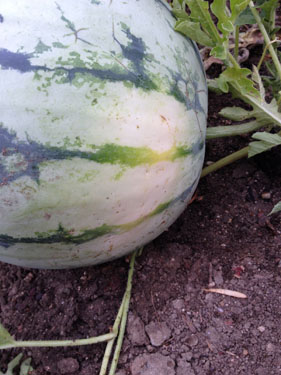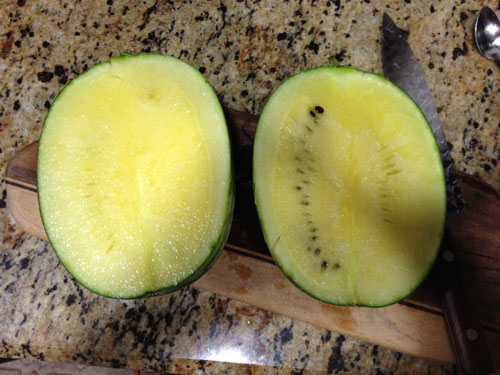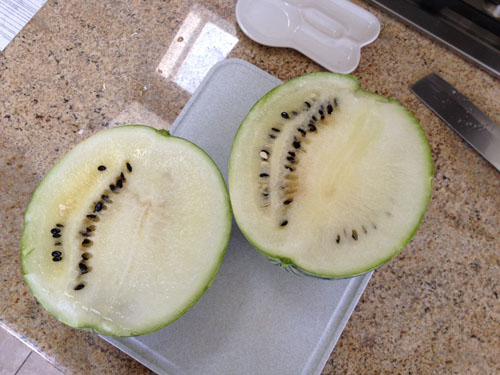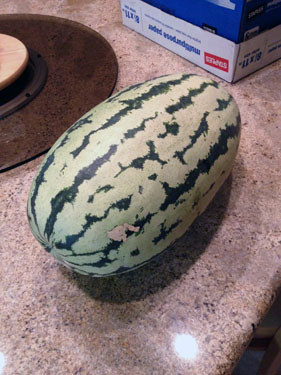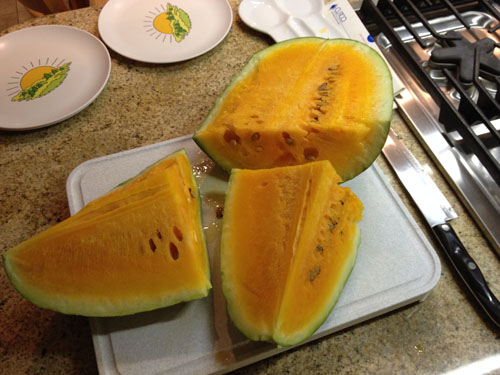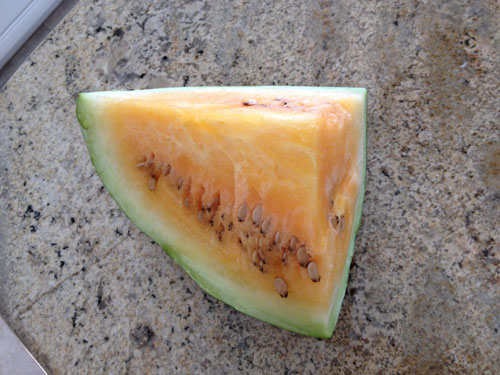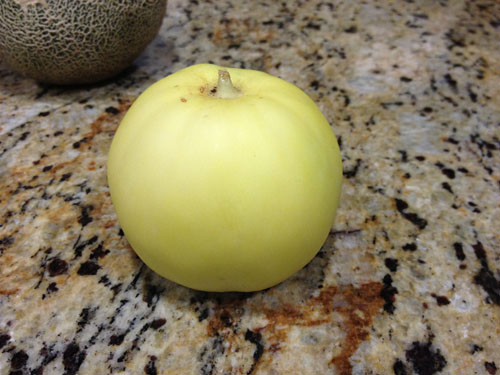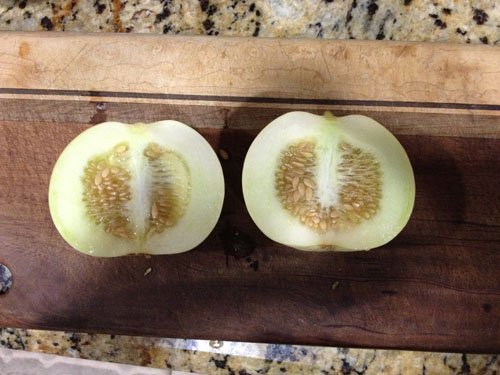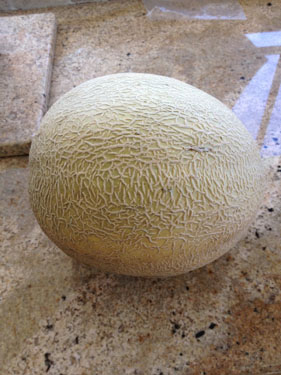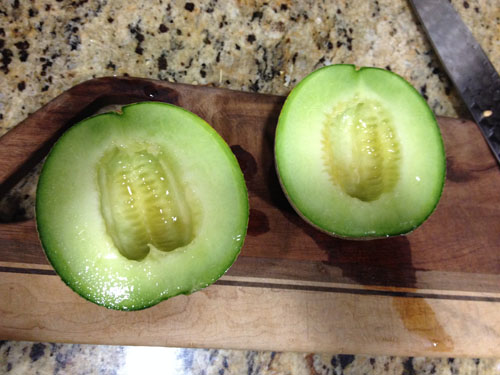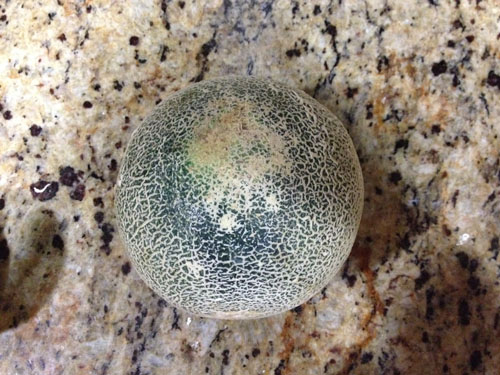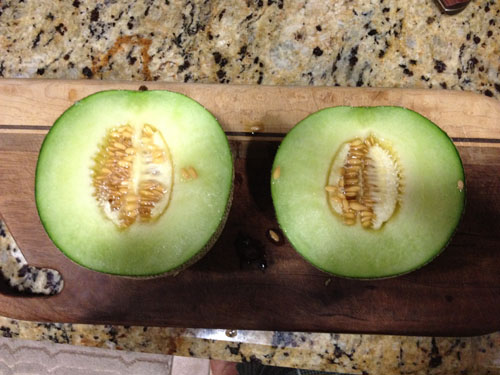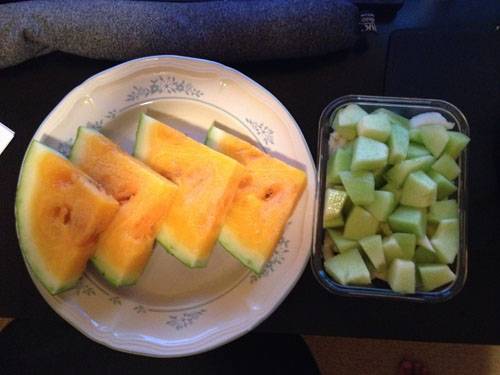Date: Friday, August 15, 2014
The garden looks like crap.
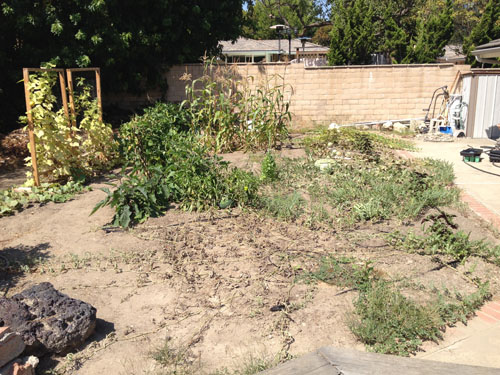
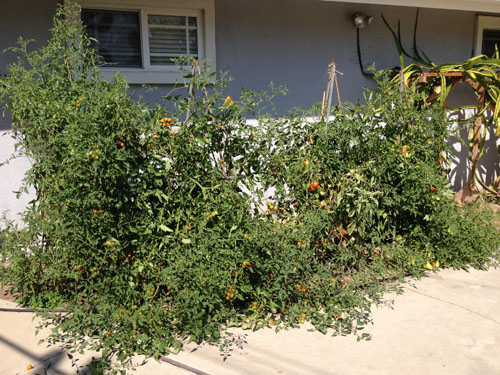
The tomatoes look okay, I guess.
I'm glad we got that out of the way. It's amazing how much things can change in just a month. Fortunately, despite the appearance I have been regularly picking things in decent abundance. I'll get to an analysis of my garden soon but first, pictures!
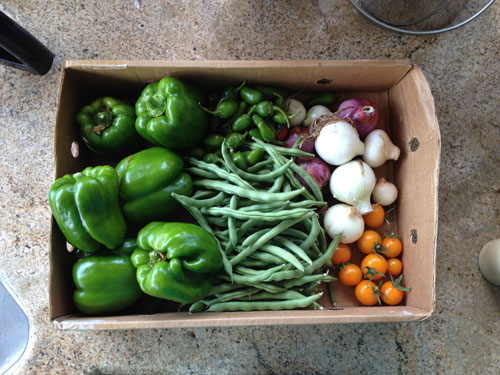
The first harvest that required a box.
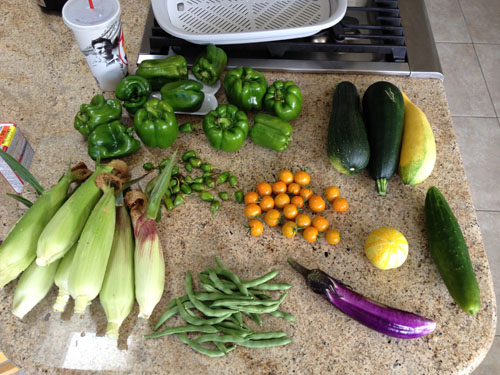
Here the plants are just starting to set fruit. There are some beans, squash, corn, peppers, soybeans, jalapenos, eggplant, Japanese cucumber, and lemon cucumber.
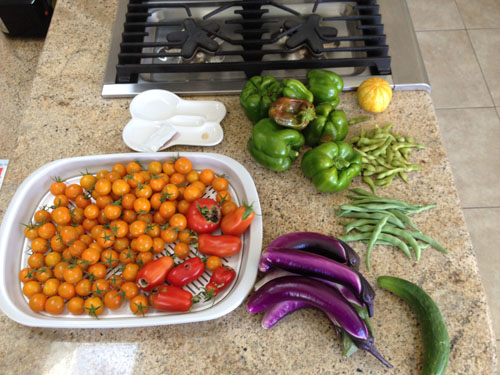
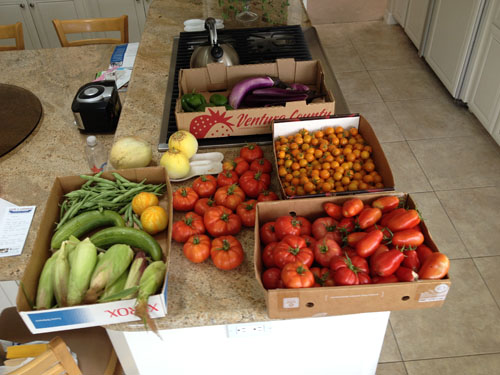
Something got mixed up in the labeling of my tomatoes and I ended up planting some anonymous variety instead of the Green Tiger I was hoping for. Now I have an extra beefsteak variety. There have been several mix-ups this year. I should remember this.
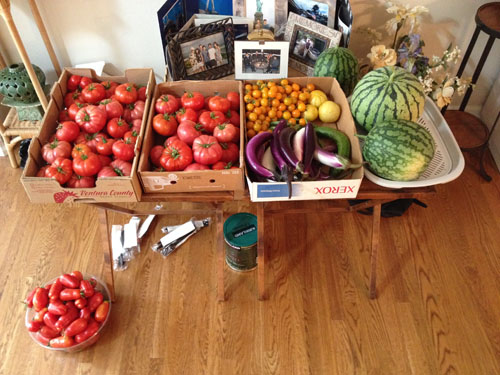
This has got to be a record for total poundage of tomatoes picked at one time. The crazier part is they were being picked throughout the week.
Those have been my pickings up to this point. I'm sure I've already crested the peak and it's a hard dive from here. Many of my plants are on their way out or have stopped producing. In fact, many of my plants are being actively killed.
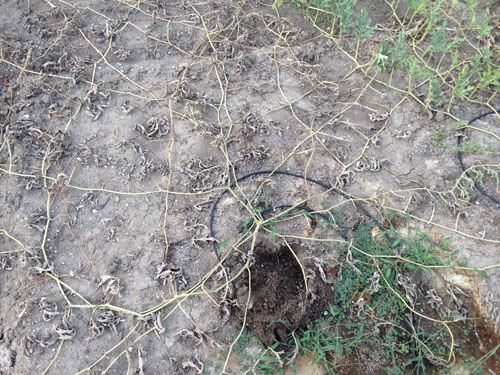
The big patch of brown at the beginning of this post is this dead watermelon. The week before I noticed a curling of the leaves which is usually a sign of water stress. At that point I knew what had happened, and there was nothing I could do about it. After the plant died I decided to dig up the roots to confirm my suspicions.
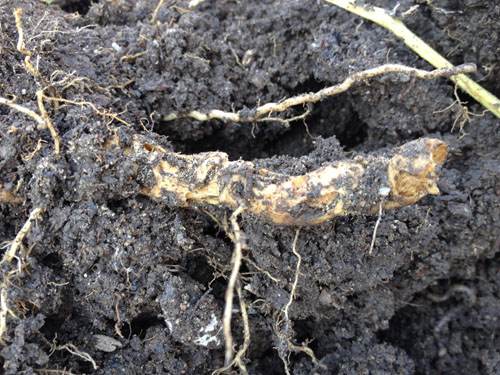
I knew it. Ant have been eating away at the root structure. No roots means no water, which means leaves start to show water stress. It's hard to see, but this is a pic of the main taproot and it is covered with holes and burrows. Plus, when I dug it up hundreds of ants came up with it and scattered. I had thought they might leave my melons alone since they've never invaded them before, but I was wrong. Fortunately, I think I finally found a solution.
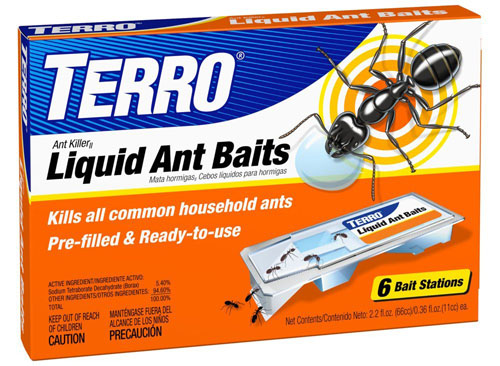

This is the Terro Ant Trap. 1436 reviews at 4.5/5 stars has got to mean something. It apparently takes out entire nests, using some kind of food solution laced with borax. The borax poisons the ants slowly enough so that they take the food back to the nest, at which point it gets distributed all the way down to the queen. Is it weird to say that I'm super excited to use this? If this stuff works, this could mean the end of my main pest problem. Ants also promote aphid populations by working with them symbiotically. If I get rid of one, hopefully it will remove the other.
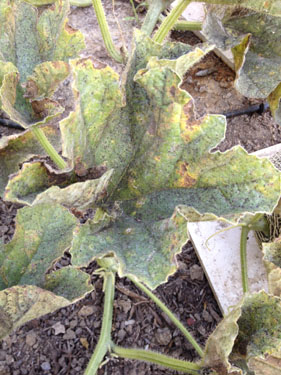
The other main problem I have is disease. Though usually not as deadly as ants, disease lowers plant yield and fruit quality. Here is one of my muskmelon leaves harboring some kind of black mold, powdery mildew, and what looks like anthracnose or downey mildew.
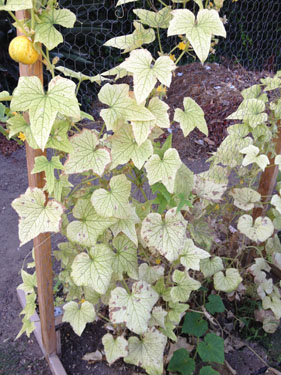
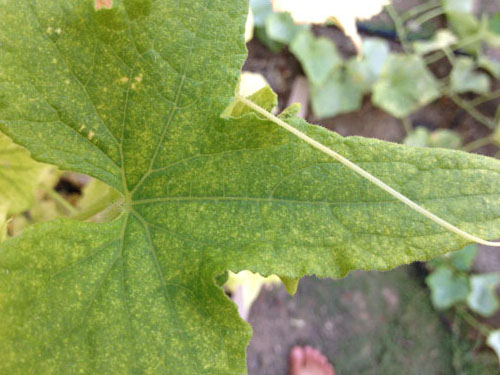
This is my lemon cucumber plant, and no, the leaves are not supposed to be this color. At first I thought I overfertilized, since yellowing of the leaves is a sign of nitrogen burn. However, I haven't fertilized in a month or so and new leaves still turn out this way. Additionally, when the leaves turn color it does so in a spore-like manner. Hundreds of tiny yellow dots appear and gradually get bigger, like some bacterial culture.
No one seems to have any effective treatment for diseases once they infect. Instead, preventative measures are always given as the best option. Some things are impractical like rotating crops, soil fumigation, constant fungicidal spraying, or getting disease resistant plants. Other things like reducing humidity and moisture I've tried to do by replacing overhead watering with a drip system. What I haven't really considered until now was strengthening the plant's own immune system. This is done by building up the soil, something I considered too expensive until now.
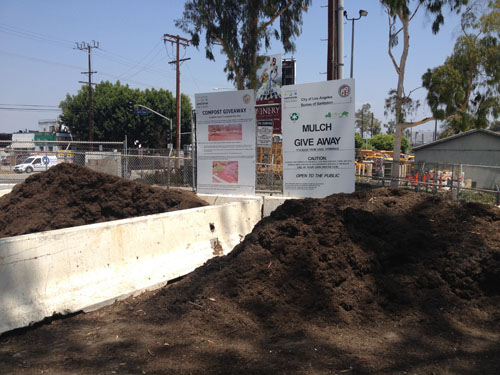
I have had two major discoveries these past few weeks. One was the Terro, the other is that LA county gives away FREE mulch and compost. ALL THE TIME. It's just sitting there, stocked every week at 11 locations throughout Los Angeles. In the past being able to acquire enough amendment to adequately fertilize my garden space would have been simply too costly. My soil square footage is too large and the quality too poor to be practically remedied by the likes of Home Depot or Lowes. This is why the free mulch program is such a big deal. The pic above is one such location. For being free it's very good compost. Not only a great source of humus (broken down organic matter), you can also tell that it is extremely bio-active. The compost was piping hot as I piled it into bags, a sign of intense microorganism activity. One downside is that it stunk. The compost uses greenwaste as well as animal feces from the city zoo. This has made my car smell literally like shit. The compost is still a little chunky and there are small pieces of contaminants like plastic in it. Still, I can't complain. I plan to eventually replace most of my growing soil with this stuff. This means a lot of trips and a really bad smelling car.
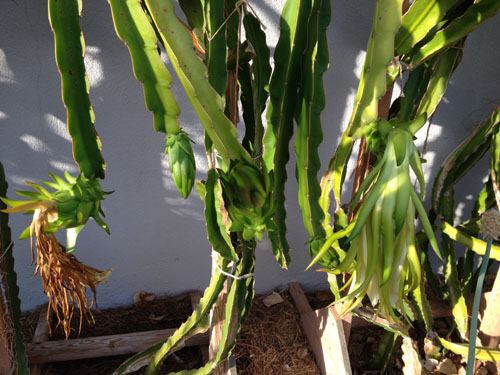
I already spread the compost around the base of my dragonfruit, which is doing amazing. So far I've counted at least 20 fruits growing, an unprecedented amount considering last year I only got one and the years before that nothing. I never imagined it, but soon I'll have more dragonfruit than I know what to do with.
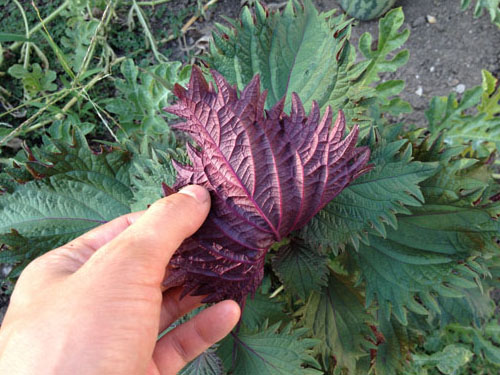
Another plant doing way better than expected is the hojiso, which looked like it was struggling at first. They're doing great and have beautiful multicolored leaves. The underside is purple while the top is green.
Every garden brings new challenges and this season was no exception. The plants have seen great success in some areas and others less so. Each time I get closer to the perfect garden, yet it still remains elusive. I consider my harvests mediocre compared to the potential I see when plants are at their healthiest. Someday I'll get this down. And when that day come it will be glorious.
Date: Thursday, July 10, 2014
Two months have gone by since my last update, yet after all this time the only news I can think of is the obvious; the plants have gotten much bigger. How big? Glad you asked.
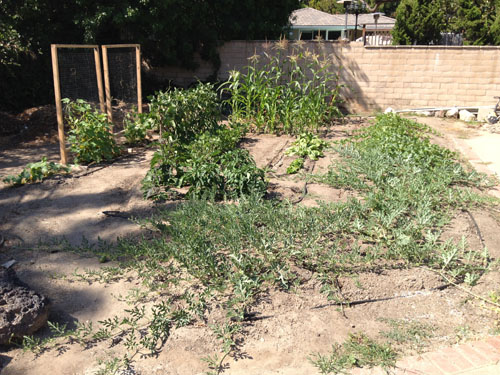
I am really the only person I know of that does this kind of thing. As a result, I have no measure of whether this is good progress or not for two months of growth. Every week when I return to check up on the garden the plants look much bigger than the previous week, yet my crop is coming in slowly. So far I've only managed to harvest some squash, bell peppers, and a single sun sugar tomato. Speaking of tomatoes...

The tomatoes are running rampant once again. I tried containing the branches within the cage, but only being able to see them on a weekly basis it's difficult to keep it in check. For some reason, this year they seem bushier and have a tendency to grow out rather than up.
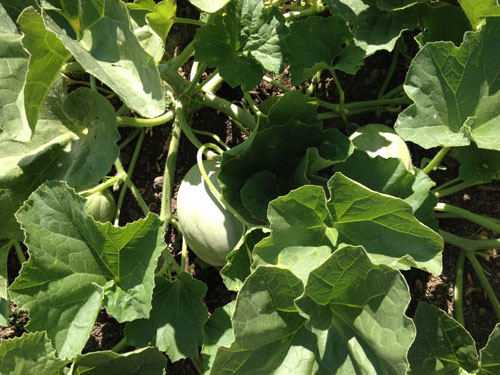
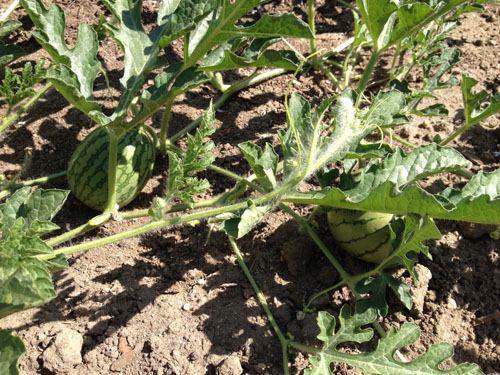
I am hoping and praying that I don't screw up my melons like I have the previous seasons. So far so good. My objectives to accomplish this are to carefully regulate watering and fertilizing, and managing powdery mildew. As far as my knowledge goes, these three things have been the bane of my melons since the dawn of time.
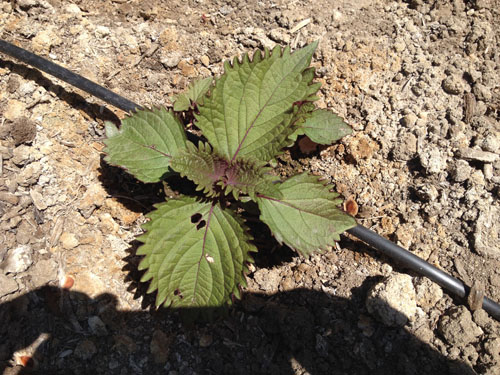
Hojiso, a variety of Japanese shiso where the leaves are green on top and purple on the underside. They don't seem to be growing very well, although I'm lucky they sprouted at all. Leafy plants don't seem to respond well to the soil in this particular spot as opposed to other places in the yard. The more I do this the more important soil seems to be.
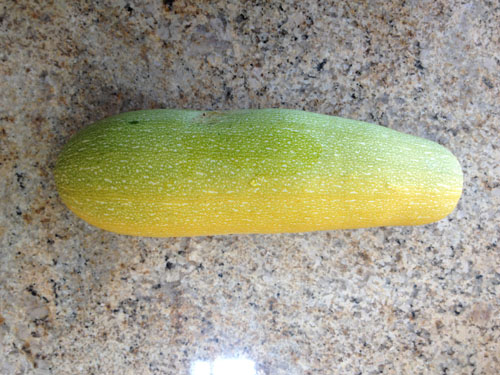
Call me a botanist because I just created a new variety of squash. I believe it is a cross between a Mexican grey zucchini and a yellow squash. This squash is a product of open pollination. Because things like squash and melons are so easily crossed many people don't even bother saving the seeds if they want to preserve the purity of their varieties. Hand pollination solves this problem, but it's a lot of work.
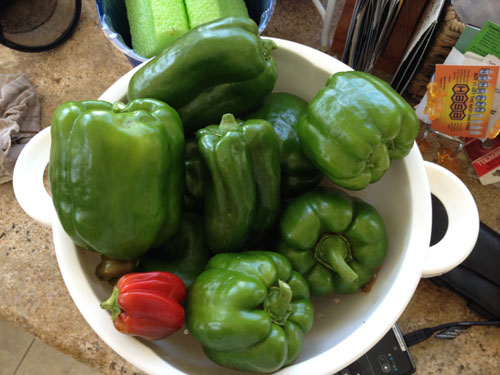
The first batch of bell peppers. They're a nice shape and a good size. Last year the peppers were big but lumpy and deformed. Again, I think the soil is the reason for the change. This is the first time I am planting peppers in the big garden patch and they seem to be responding well.
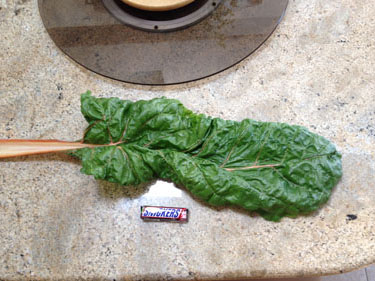
A Swiss chard leaf next to a Snicker bar. The chard is eaten constantly but is still completely unfazed.

There's always that one spot in the garden that doesn't do well, although this time I'm convinced it is not my fault. The barren row on the left was supposed to be spinach, but as they were sprouting fire ants ate their roots away. They have also infested my michihli at the far right. Out of all the pests, fire ants have been the biggest pain. I can't get rid of them, they're everywhere, and I can't even tell what they're doing to the plants because it is all underground. Plus, they bite and it hurts.
The other reason for the poor performance is the watering system here, which utilizes a soaker line. At first they worked well, but I quickly found out the pores are easily clogged by mineral build up. Now they barely emit any water. I've resorted to poking holes in them with a needle but these also seem to get clogged eventually.
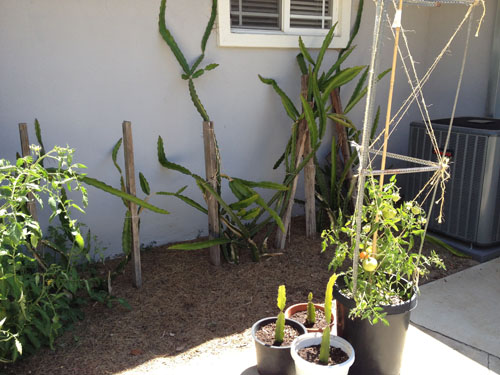
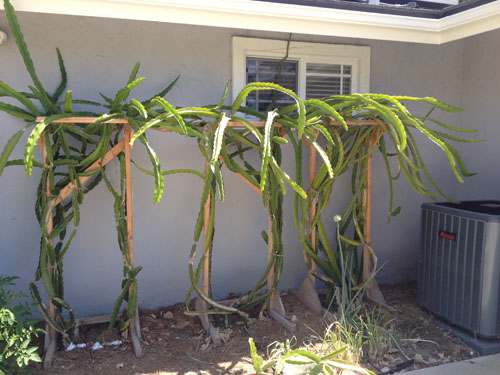
The first picture is the dragon fruit plant just last year, the next is the current plant. One thing that seems to spark growth is pruning. At the very least it is getting bigger, but has so far generated only one fruit. That may change soon though.
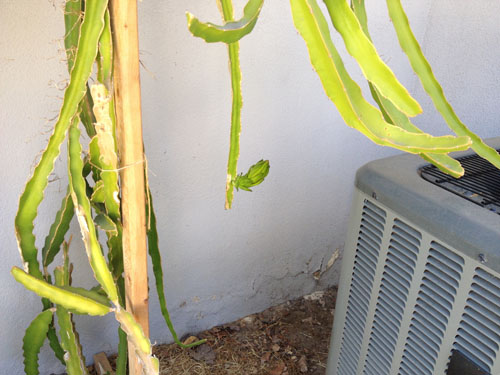
I got another dragon fruit flower, and much earlier than the last time. It's not much, but I call it progress.
So it's not the perfect garden I envisioned just a few months ago, but as long as I'm learning new things it's worth it... right? I've yet to harvest any substantial amount so I can't gauge success yet. Here's hoping the next few posts will be boxes full of fresh produce.
Date: Tuesday, May 13, 2014
These past several weeks I have been putting my best efforts into gearing up for the summer season. Somehow, despite living away from my garden plot I managed to create even more work for myself. Many people would call me crazy. I will say, however, that what I am about to show is indeed glorious.
Between this post and the last the existing garden has been uneventful. Things are slowly dying, being pulled out, or being eaten, as gardens usually go. Below are the last remnants of the cool season crop.

The chard doing its thing. Chard is related to the beet, giving it that vibrant color. Good cooked or raw. Easy to grow and lasts forever. The question is, what can't chard do?
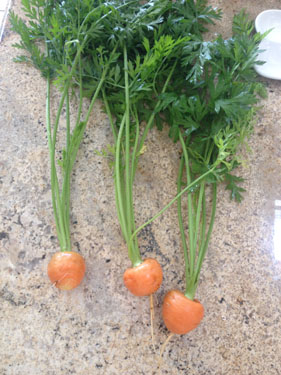
Tonda Di Parigi carrots. Hilariously stumpy variety that is more of a mouthful than it looks. Unlike my carnival carrots, these guys are supposed to look this way.
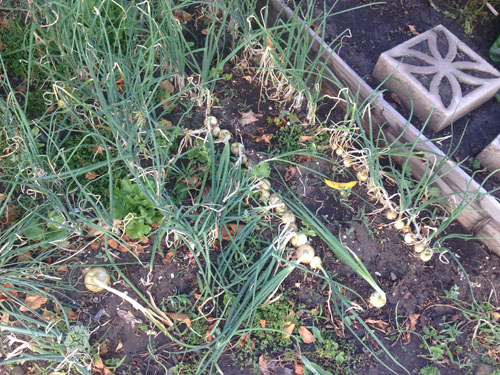
When onions are ready to be pulled the stalks start to fall over. I am thinking of saving these bulbs to use as planting shallots for next season to get a bigger crop. My onions were spaced too closely together this year. In fact, they weren't spaced at all.
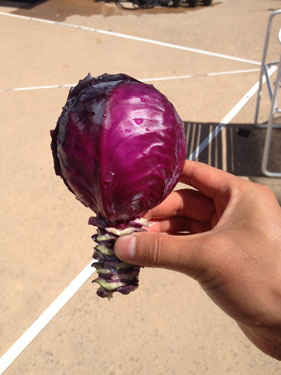
A tiny red cabbage. Looks like a light bulb.
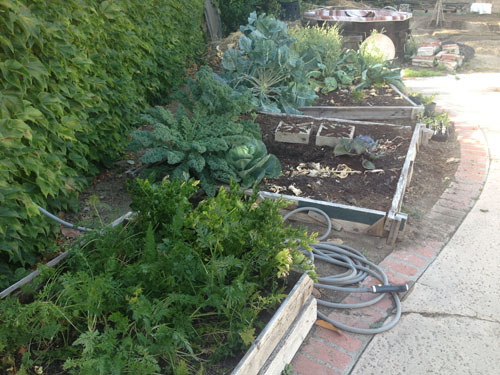
...and the rest. Eventually all but the kale, Brussels sprouts, and celery will be pulled.
Now for the gloriousness. I don't think I have ever worked so hard to prep my planting space before, but at least I'm off to a good start.
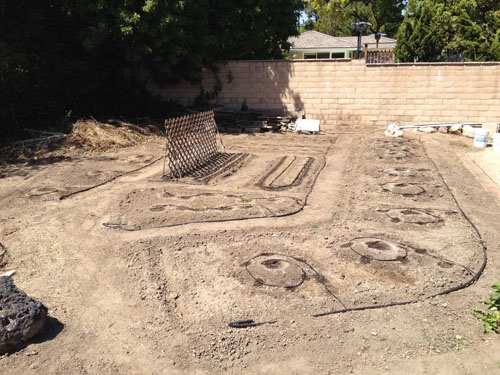
This year is hopefully the year I do everything right. This year I made it a point to have good garden design with well defined pathways. I hand-tilled the soil and mixed in 6 or 7 bags of Kellogg amendment, 2 bags of Miracle Gro garden soil, and 1.5 bags of sphagnum peat moss. After that I groomed the soil, made planting hills and furrows, and raked down the pathways.
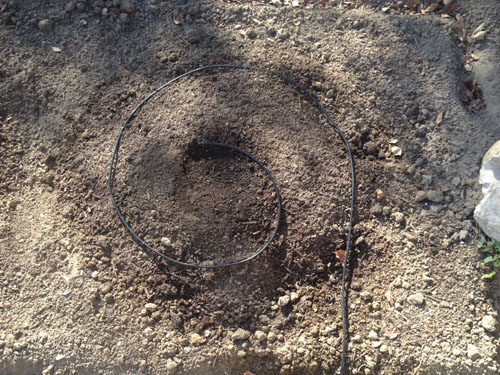
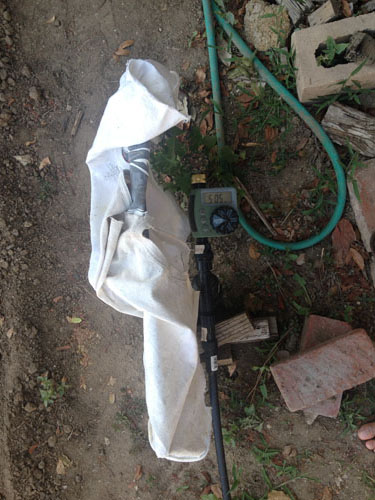
It gets more ridiculous. Because I am away from my planting space during weekdays I decided to install an automated drip irrigation system. Drip irrigation is a series of pipes and tubes that deliver water to the plants via small holes, or emitters. These pipes are hooked to a timer which toggles water flow.
There are generally two types of tubes used which are the 1/2" mainline tubing and the 1/4" microtubing. The mainline tubing acts as the trunk of the system that the microtubing branches off of. Here, the microtubing can be switched between three types, known as tube, dripline, or soaker line. Dripline and soaker line are specialized microtubing that emit water. Tube is simply, well, a tube.
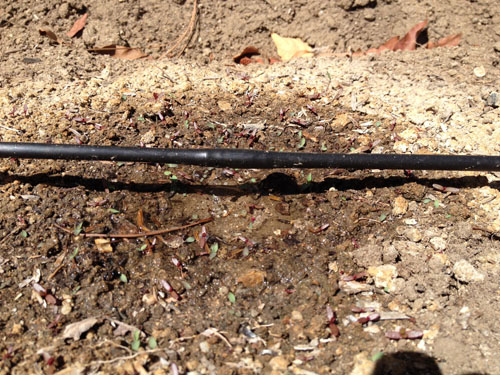
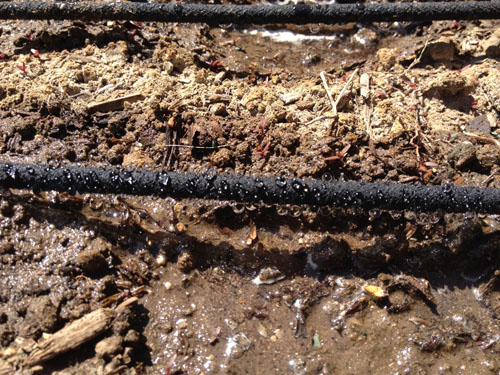
Dripline (above) is tube with a series of holes punched in at a certain spacing, typically 12". Soaker line (below) is a completely porous tube where water slowly beads out along the entire line. These are the two ways my plants will be watered.
Irrigation systems are expensive and, since this was my first time using one, time consuming to install. I had no clue what I was doing, resulting in several trips to Home Depot, a lot of head scratching, and staring. Due to the high up front cost I wouldn't recommend this system to everyone, however there are several benefits beyond automated watering which makes this option appealing:
1. Even, consistent, deep watering - ensures that the same amount of water is applied each time and at every emitter. Because the emitters drip in the same spot water gets pushed downward into the deeper root zone, something that is hard to do with a garden hose. Even watering also means more consistent seed germination.
2. Eliminates soil erosion - drip irrigation applies water at a very slow rate, causing no movement to the soil below. This is especially important during the germination phase when sprouts are most frail and vulnerable. I have a feeling that much of my germination failure had to do with my aggressive watering methods. As the plants get bigger, the lack of erosion also means less exposure of the roots to the surface. In my experience, it is best to keep the roots underground.
3. Allows for morning watering - perhaps I am lazy, but I have always refused to wake up at 6AM to water my plants. Having the system automated prevents this issue. Morning watering is beneficial because it prepares and sustains plants as the day gets warmer and sunnier, analogous to hydrating before going on a long run. They also say that it allows the plant to dry early, however the drip system makes this a moot point.
4. Reduces disease and fungus - many plants are much more prone to infections if their leaves are continually wet or if their surroundings are damp. Drip irrigation doesn't wet the plant at all.
5. Extremely efficient - Water goes straight from the tube to the roots, reducing evaporation, runoff, and water in unplanted zones.
6. Weed reduction - as a corollary to efficiency, since the watering zone is reduced, so are the areas in which weeds can grow. This both saves time weeding and prevents the plants from having to compete for nutrients.
I still have a lot to learn but I am excited for the possibilities. If this drip thing works out these benefits may make my garden the most successful it has ever been, with drastically reduced input to boot.
---------------------------------------------------------------------
Garden Design:
Believe it or not, there is a logic to placing plants. I'm sure it can get more sophisticated but this is how I go about it:
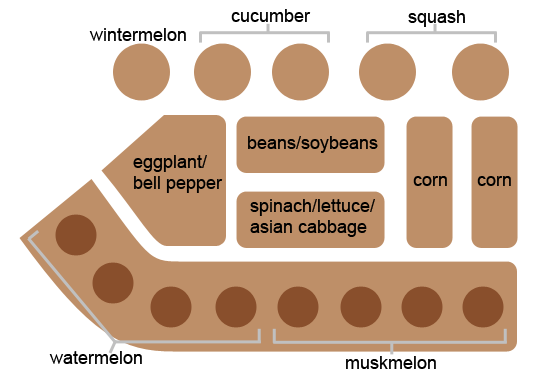
Summer is a time for sun loving, heat loving, or at least heat tolerant, plants. While I have said before that things like spinach, lettuce, and cabbage are usually cool season crops, experience has shown these particular plants fare well even in hotter temperatures. The lettuce is a heat resistant variety developed in Hawaii at UH, called Manoa lettuce.
I placed the viney plants like the cucumbers and watermelon along the edges where they can spread into the unplanted areas of the garden. The corn is in the very back as to not block sunlight for the rest of the shorter plants. The sun shines from the left in the diagram. The rest of the plants are small and unobtrusive enough to be planted anywhere in the remaining space. For whatever reason, I kept like plants in the same space. Beans with beans, leaf crops with leaf crops, eggplant with... pepper... I guess. When it comes to which variety to pick whatever is available has been the strategy.
The full list of what I'm growing in this space is below:
Wintermelon - Okinawa Tougan
Cucumber - Japanese and Lemon
Squash - yellow and Emerald Delight
Eggplant - Dusky, Ping Tung, and UH Green
Pepper - King Arthur and Purple Beauty
Beans - unknown pole variety, unknown soybean variety, and a Japanese black seed soybean variety
Spinach - Bloomsdale
Lettuce - UH Manoa
Asian Cabbage - Michihli
Corn - unknown sweet corn variety
Watermelon - Mellow Gold, Orange Tendersweet, Cream of Saskatchewan, and Orangeglo
Melon - Yubari, Shizuoka, unknown Japanese variety, and New Melon
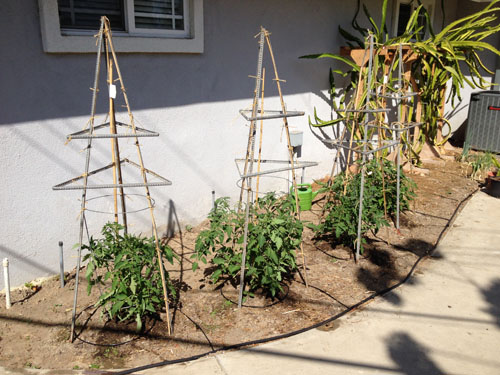
Lastly, who could forget the tomatoes. Due to the success of last year, the setup is exactly the same. This year I have Sun Sugar, San Marzano, Green Tiger, and Mortgage Lifter. The story behind the last name is that the person who invented the variety sold enough of the tomatoes to pay his mortgage. I'll need to repair the trellises and figure out a way to keep them from toppling. I have some time before they get that big though. This is a bad picture. I'll update it soon.
Edit: finally updated the picture.
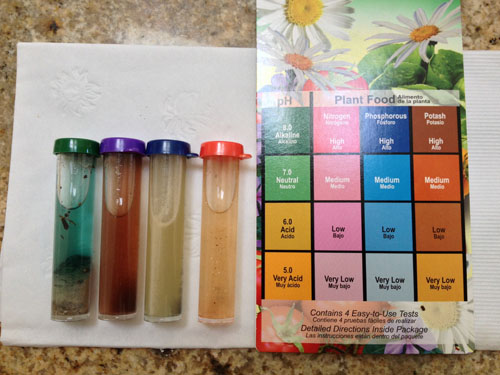
Lastly, I finally got around to testing my soil using a cheap DIY kit from Home Depot. The tubes from left to right correspond to the colors on the cart representing in order: acidity, nitrogen, phosphorous, and potash. Unfortunately, due to a rushed schedule I tested it after all the prep and planting. Not that I was willing to buy all the products to balance the soil anyway, but now I know for the future.
I can't imagine how accurate a $3 soil test kit can be, but preliminary results show that I have a neutral/alkaline soil. I dunno, the color looks bluish to me. I seem to have a lot of nitrogen, but am completely lacking in phosphorous and potash, which is bad. These three chemicals are the key components in most fertilizers. The packaging will usually have a number like 12-12-12 or 10-10-8, denoting the N-P-K, or nitrogen-phosphorous-potassium, concentrations. So I have a partially alkaline soil when I am growing acid-preferring plants, and I have almost no concentration of two-thirds of the three main nutrients. Wooooooooo!
Aside from the soil, things are looking up. I have high hopes for this year and so far it is off to a good start. With luck the dripline system will solve most of my major problems and the best part is I won't even have to be around to take care of anything. This is all speculation of course. Only time will tell how it will actually play out. These are exciting times. I shall keep you updated.
Date: Sunday, April 6, 2014
Wow, where does the time go? Winter is over and the garden I planted back in November is now on its last legs. As the season winds down I can reflect on what happened during this time and how I can improve for the future. The pictures at this point no longer display the vigor and possibility of youth, but rather the weariness of age. Brace yourselves...
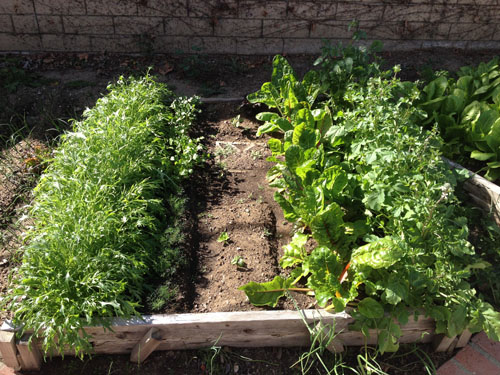
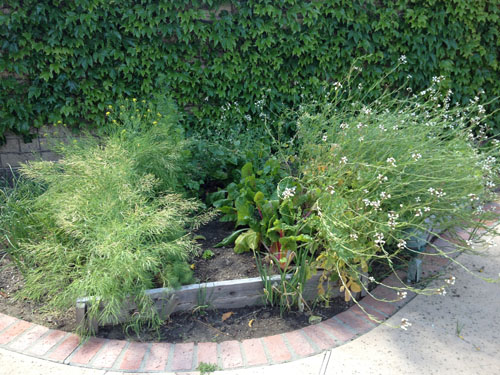
Some progress shots of box 1. The mizuna and arugula have since been pulled out, leaving essentially just the chard. When bolting occurs, leaves become tough and mostly inedible. If the seeds aren't needed there is no reason for the plant to stay in the box.
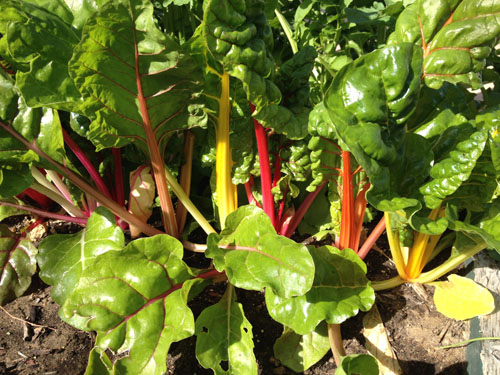
I do not know how long Swiss chard actually lasts, but I hear it is for several seasons. Thus far the plants have shown no signs of bolting or old age. Easy to grow, long lasting, colorful, and nutritious. Highly recommended for any garden.
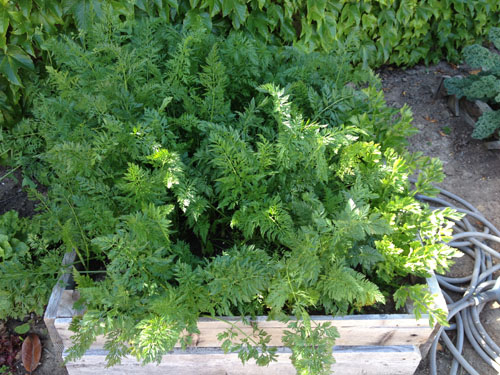
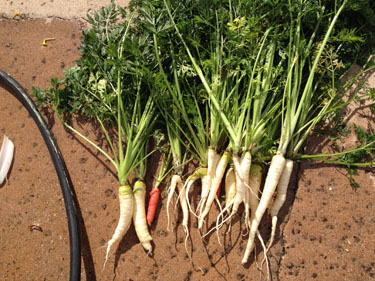
From the surface the carrots appear to be thriving, but I have learned the tops can be very deceiving. Some harvesting reveals a mostly small, segmented crop. I'm not entirely sure what happened this year, given that last year's plants were fairly decent. On the plus side, the celery is doing better this time around.
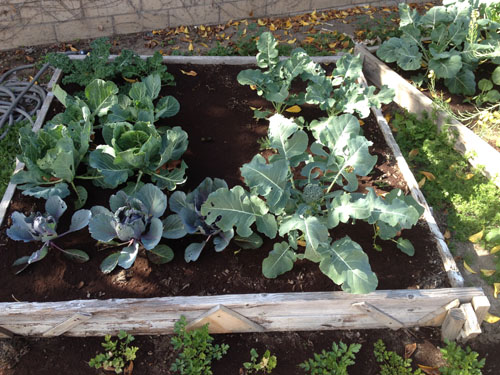
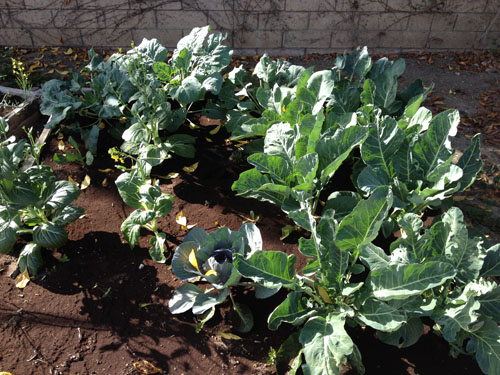
Back in February I gave the brassicas a groundcover made of coffee grounds I got from the local Starbucks. In retrospect this was a terrible idea. I tried to use it as a type of bug repellent and high nitrogen fertilizer, but the high acidity (and perhaps the nitrogen) shocked the plants. Luckily most of the plants survived.
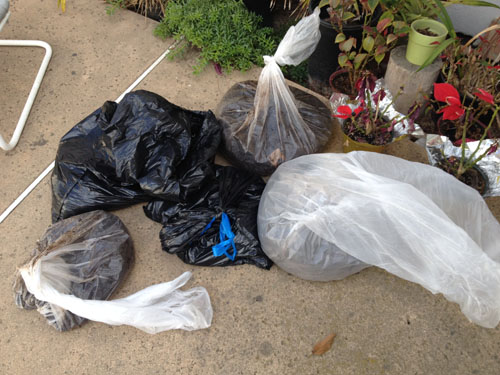
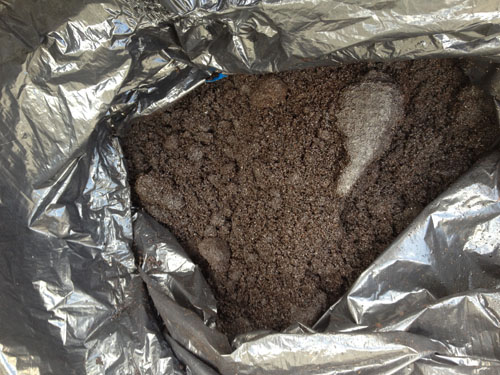
On that note, Starbucks has a nice recycling program allowing anybody to pick up their used coffee grounds for free. Just ask them to save some and come back the next day for a huge bag, granted that they remember to do it. The bags shown represent just a few days worth of collection, from just one store.
Why, you ask, would you want coffee grounds after they clearly have a negative impact on plants, as I described above? What I did wrong was 1, use too much, and 2, use it on the wrong plants. Acid loving plants like blueberries and melons will probably respond better to grounds. It is also a good idea to compost them first, and not use so much in one spot. Like anything, it is best in moderation. Since I used it as a groundcover I didn't think it would have such a drastic effect, but this was quickly proven wrong. In short, if you are looking for a plentiful, free fertilizer source, look no further. Just use it wisely.
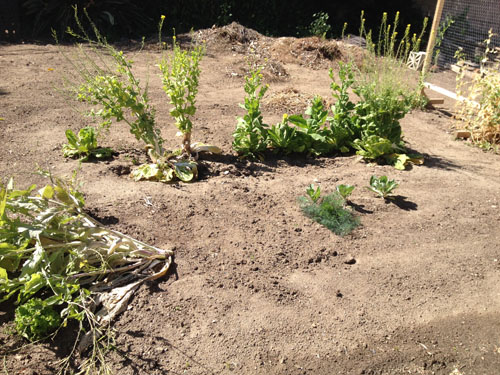
The Asian cabbages are done for. What hasn't already been pulled has bolted or been chewed up by fire ants. Although the plants grew quite large, they never did get a chance to form heads. More on this below.
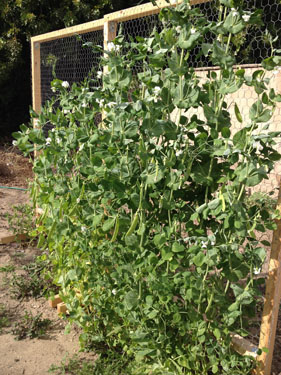
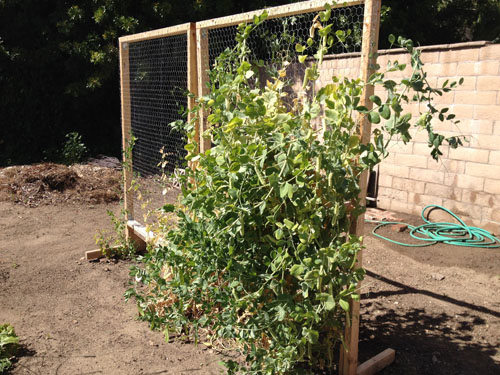
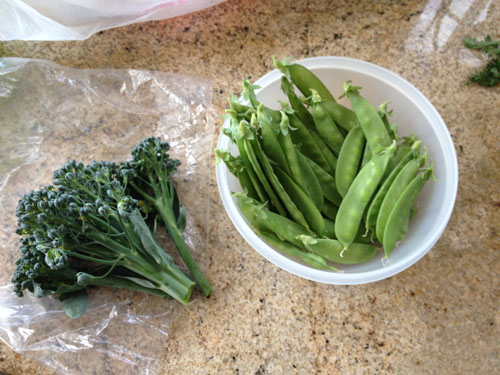
The snow peas at a time were about seven feet tall. Since then they became so massive that they collapsed in on themselves. And I thought I was being conservative when I made the trellises almost six feet. Snow pea pods are prolific but are quick to mature. If not harvested fast enough, the pods become large and round as the seeds mature.
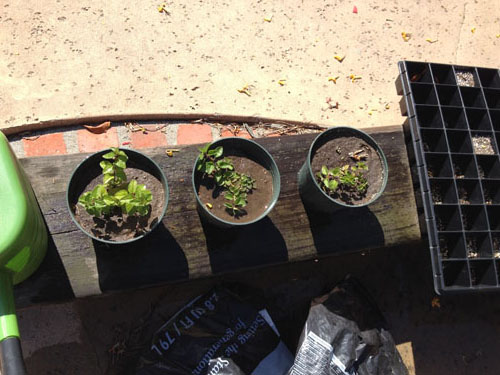
The oregano. Herbs are nice because they tend to be perennials, meaning they last longer than two years. Btw, a rule of thumb to distinguish between an herb and a spice is that herbs are generally the leaves of plants, while spices can be most everything else. Just in case you're wondering.
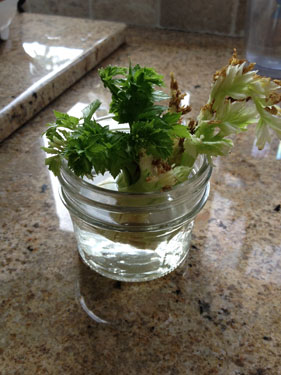
I also learned that celery stumps can be rooted by placing them in water, much like a pineapple. This may save me the trouble of planting from seed. Any store bought celery or otherwise will do.
------------------------------------------------------
I'm sure it is unsurprising that my plants look the way they do today. Plants sprout, grow, get old, then look terrible. What I really wanted to write about is what I learned from this year's winter season. I think it's safe to say that I still have a lot to learn about growing things. My gardening thus far has been inconsistent and sometimes based on pure luck. Slowly, my methods have been getting better through a process of trial and error and some research through books and the internet. Below are some of the more important lessons I think I can take away from this year's bout.
- Winter season plants need to start in September. The past two years I've been planting in mid-November, but I have noticed that many of my plants bolt prematurely before they can develop the crop I intend to harvest. Bolting occurs when the plant senses warmer weather. Bolting diverts the plant's energy from growth to seed production. Planting in November does not give the crop enough time to mature before experiencing a shift in seasons. Planting in September just might enable things like the brassicas to fully mature during the coldest time of the year, thus reducing the chance of premature flowering.
- Fertilizing practices need to be refined. Aside from the coffee grounds fiasco, at one point I applied a liquid fertilizer to my Asian cabbages which burned the leaves. Currently I am pretty careless in my application, but I need to have a better understanding of the requirements for my individual plants and the correct application methods for the fertilizers I buy. Due to time constraints and availability, I tend to amend and mix compost into the soil immediately before planting. Gardening books and other sources typically suggest planting in a well composted soil mix, which means that after amending to give the soil time to rest and "equilibriate" before planting.
- Watering practices are too rough, especially in the beginning. Harsh watering erodes the soil and can also expose the roots of young plants. Recently I bought a few nozzles that may solve the problem. I now have a seed mister for sprouts and a fan nozzle that provides a gentle stream and maintains a high output.
- Furrows are too narrow. This is related to my watering practices which tend to erode my furrows. Even with gentler watering they are still susceptible. I plan to make the furrows wider and with shallower angles to form the trench.
- Plants need to be in trays longer. Much of the hardship involved with the brassicas has been bugs eating the leaves of the sprouts. Perhaps if I allowed the brassicas to mature in trays they would be more resilient after transplanting.
There are certainly more areas of improvement, but for now these points will provide enough brain tickling. Despite the rough patches I still believe I have come a long way. There is so much experimentation going on that my ideas are in a constant state of flux. Soon, those ideas will congeal and I'll have nothing left to say.
And so comes to a close my winter garden. It wasn't the perfect crop I was envisioning, but hey, I've been eating some pretty good salad and all the snow peas I could want. Plus I got a lesson or two for good measure. So remember kids, just say no, because drugs are expensive. Good night!
Date: Sunday, January 26, 2014
It is near the end of January somehow. The weather has been unusually warm for wintertime, but days are still short and nights can get cold. California is also experiencing some of the worst drought conditions in its recorded history, no thanks to me and my trusty garden hose.
The garden so far has been a mixed bag of successes and failures. Some plants are growing better than ever, while others I seem to have actually gotten worse at growing. The shorter days and insects don't help either. Let us check out what has been happening on the "farm."
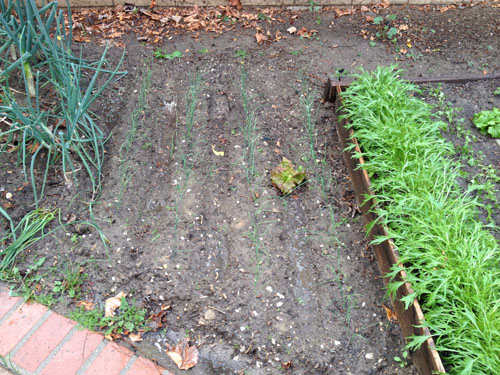
My onions are growing slowly. At this rate I won't get a crop until perhaps April. I am not sure if it normally takes this long for onions to bulb. I planted them in one of the spots that gets the least amount of sun which could be the problem.
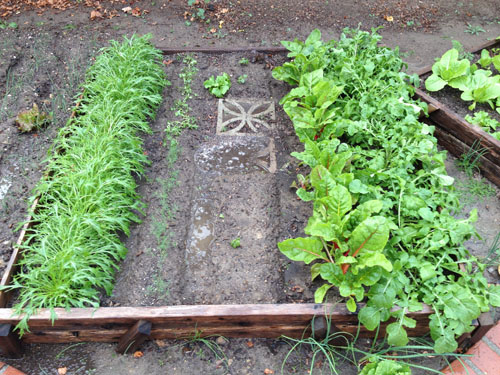
This box is doing quite well, except for the shiso. My mizuna, dill, cilantro, chard, and arugula are doing fantastic. The shiso in the middle have had a rough life from the start. The leaves are constantly being eaten by things, and upon further research this plant appears to enjoy late spring/early summer type weather. Oops.
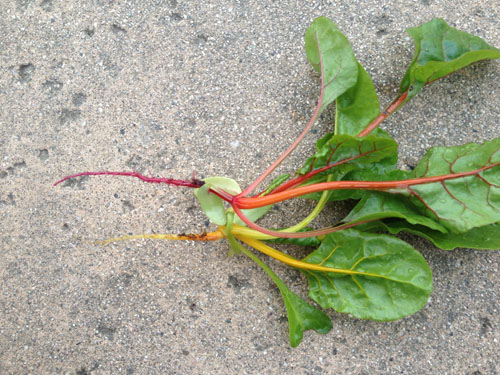
Swiss chard. I like how the color of the plant carries into the roots.
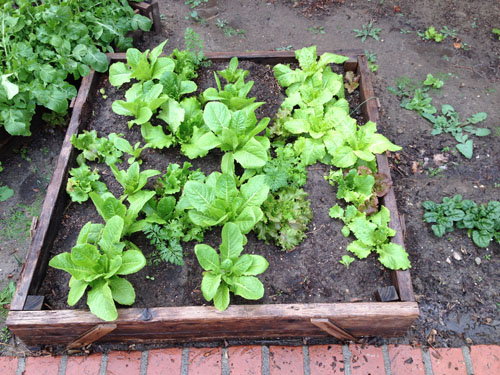
Head lettuce, including Romaine and Iceberg. There were some stray seeds that sprouted along with what I intentionally planted. Instead of pulling out the wild ones immediately, I am going to let them grow to a decent size them harvest them.
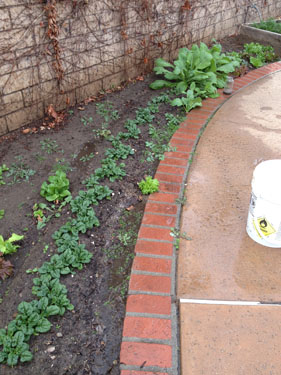
Spinach, spinach mustard, and salad bowl lettuce. This area has had a tough time with pill bugs which I unwittingly released upon my plants after dumping my tumbler compost here. The pill bugs kept eating my sprouts, my crop was being annihilated, and I resorted to going out every night and picking up all the pill bugs I could find and putting them in a jar. After all that I don't think I put a dent in their population.
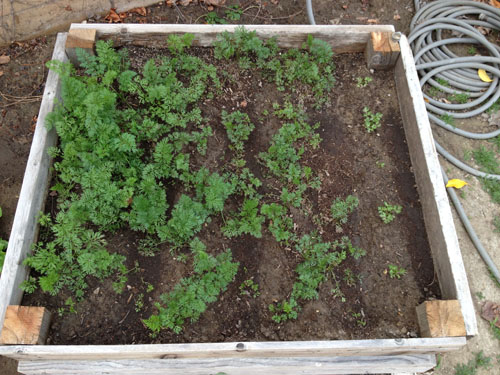
Carrots. This is embarrassing. Where my carrots are growing in no way represents the zigzag pattern I originally planted them in. This was due to a panic attack I had when I first set the seeds. I thought I planted them too shallowly, so I dug them up, replanted a little deeper, and stupidly did not expect the uprooted seeds to germinate. Many people wouldn't care as long as they got some good crop out of it, but I take pride in the aesthetics as well and this is definitely an extreme violation of garden feng shui.
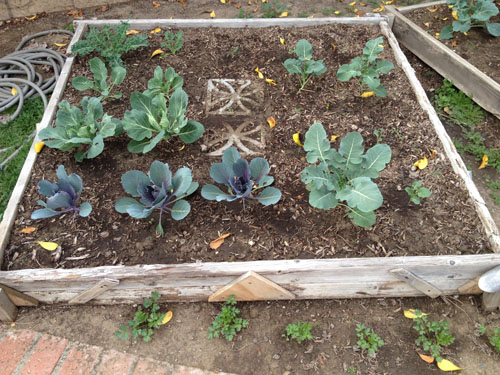

Brassica patch with noticeable gaps. Brassicas are hard for a few reasons. The first is the tiny seed, requiring a delicate germinating process which I have not perfected yet.
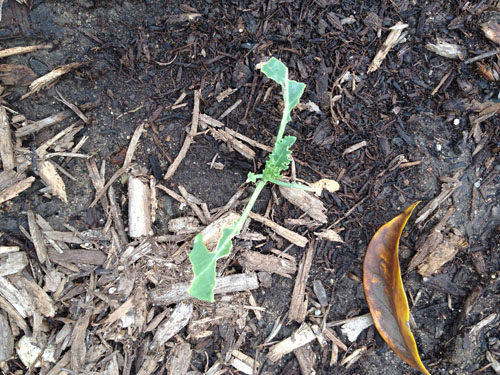
The second is the pests. Many bugs eat the leaves and some, like aphids, infest and are impossible to remove. I never had much success direct sowing or even transplanting brassica sprouts due to the pests. My next strategy is to grow them in trays to a more mature size before sticking them in the ground.
Lastly, I don't quite understand all the variables that would determine a good brassica crop. This is because, unlike other plants that need to be just healthy enough to produce good leaves or fruits, brassicas are required to behave and grow a certain way to get the best results. Broccoli heads don't always bunch up but can spread and flower. Brussels sprouts don't have to bunch up either. Some people have no trouble with them but brassicas don't seem to care for my backyard.
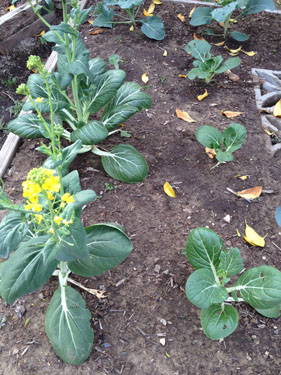
I thought I planted brocoverde here, but I think this is bok choi. Unless bok choi seeds managed to get into my brocoverde packet, I'm not sure how this could have happened.
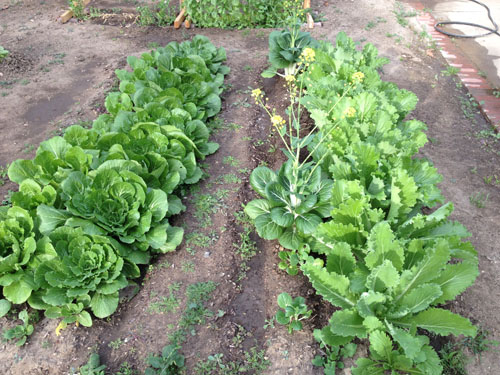
Asian cabbages. Oh my gawd, I can't even look at these things. I should quit right now if I'm growing plants this poorly.
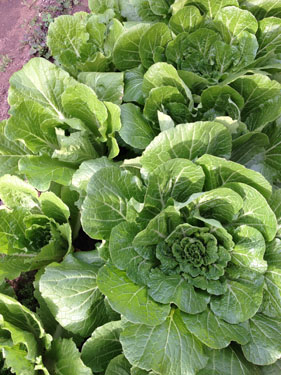
Why are they so green? Is that normal? They say too much of a good thing is bad. I know plants are supposed to be green, but I must be doing something wrong if there is this much chlorophyll in one spot.
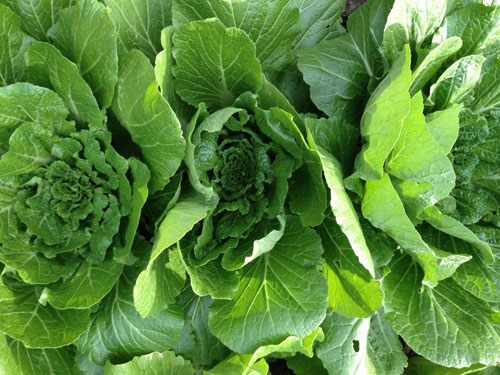
I can't even get the napa to mind their own space. They're growing so big they're just running into each other. Geez!

The bok choi were growing so fast that I had to pull and eat most of them already. I can't even get my plants to pace themselves. I suck.
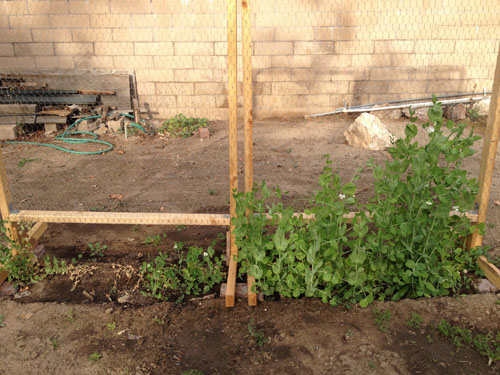
Snap peas and snow peas. The snap peas are basically dead. My biggest mistake with the peas has been, of all things, the trellis design. It is too tall, giving the peas nothing to latch onto when they're young sprouts and causing them to fall over or cling to adjacent plants. Also, and I'm not trying scapegoat here, I have a feeling my snap peas are not the strongest variety. Both types have had the same growing conditions and just look at them.
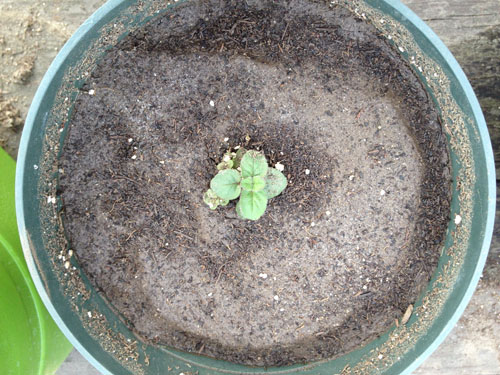
Giving oregano a shot. Oregano is a small bush perennial that start off as the tiniest seeds imaginable. It actually makes more sense to purchase as a young plant from a hardware store.
There is more to tell but I'll end it right here. It has been roughly two and a half months since I started this garden. What has always been a little unnerving to me is that I have no frame of reference to the quality of my plants. Of everyone I know, either nobody grows things like I do or talks about it. There is no metric for whether I am doing a good job or not. I guess in the end, the plants speak for themselves. So is it a good garden? That is for your to decide. But the answer is, yes.
Date: Monday, December 2, 2013

I've been a naughty person
No Christmas present for me
Of all the times a browser fancied
T'was nothing new to see
Well I'm back, my friends
I didn't forget
It's finally here again
Let's all learn about brassicas
About alliums and then
About apiums and lettuces and solanums and more
Let's all learn about growing things
That's what this blog is for
Hooray!
Well that was fun. Catching up, since November I've been working on prepping and planting my winter vegetables. The hard work has already been done and things are just starting to sprout. Cooler weather generally means leaf, root, and bulb type crops which I'll elaborate on below. Remnants of the previous summer crop are still hanging around and giving me a surprising amount of produce, but I have a feeling that won't last much longer.
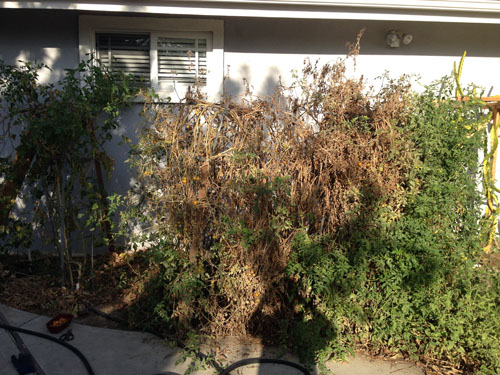
Summer is long gone and the tomatoes are just getting the memo. The Purple Bumblebee and Heat Wave II are dead with the Sunsugar not far behind. If old age doesn't kill them then the frostbite eventually will.
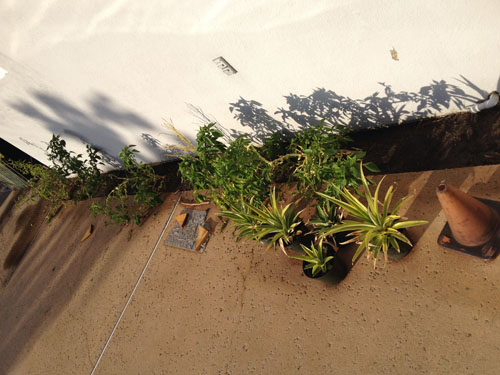
The bell peppers have been surprisingly resilient and the pineapples are surviving. Since pineapples can't tolerate cold weather I have to put them indoors every night. I can see why nobody grows them around here.
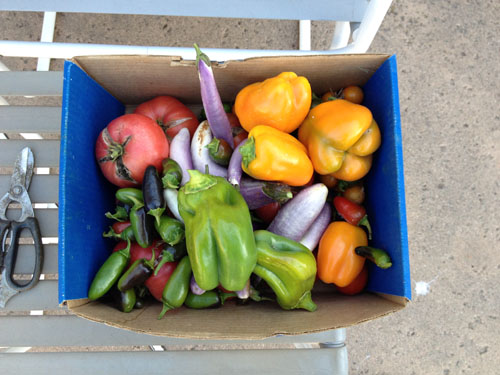
And yet, from the dingy remains come a rather nice harvest, granted this doesn't happen often.

My single jalapeno plant somehow sustained all these peppers at one time. I hadn't picked them in a while and this is what happened. The plant was falling over because of it.
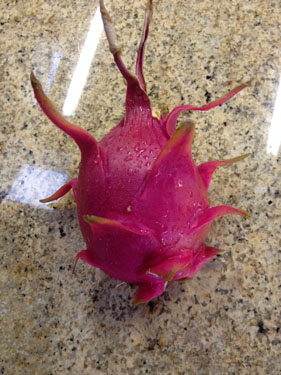
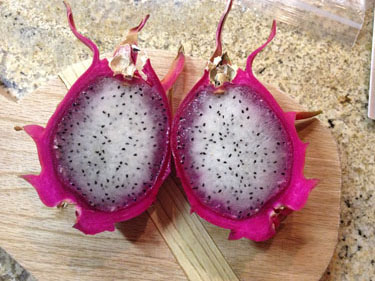
Finally, my miracle fruit. The dragonfruit flower I thought was doomed managed to grow into a nice, albeit small, bulb. I didn't realize they self pollinated, but one thing I'm pretty sure is not normal is that it took several months to ripen. What is with this freaking plant? The taste and texture is very much like a kiwi. I'm sure I've said this before.
----------------------------------------------------
Getting back to the winter stuff, my garden started out with preparing the soil at the beginning of November.
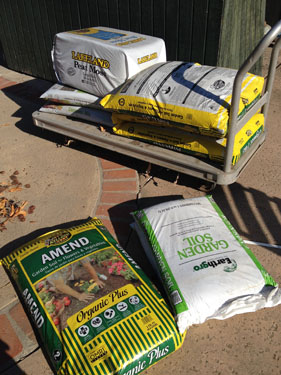
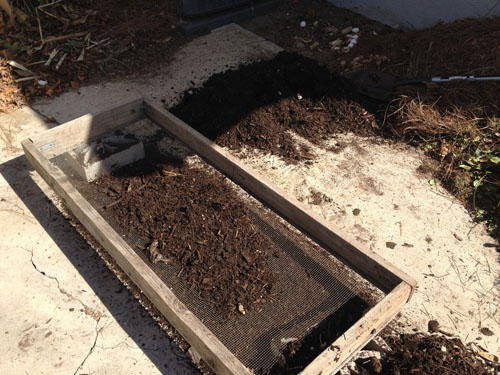
The first thing I did was buy several different types of soil amendments which included Kellogg Amend, Earthgro Garden Soil, EcoScraps Compost Mix, and Lakeland Peat Moss. The peat moss is used as a soil conditioner and is supposed to help with moisture and nutrient retention. The EcoScraps mix is cool because it is mostly made from composted fruits and vegetables. It is also twice as expensive. I'm really just experimenting here to see which gives me the best results. I also used my homemade compost after filtering out all the bigger uncomposted chunks. Obviously, my compost should perform the best.
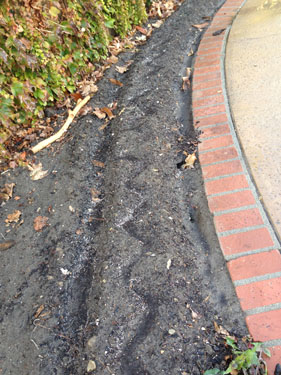
I mixed all the amendments into the soil and dug the furrows. On the wider hills I created zigzag depressions for the seeds to increase the amount I could fit in a single row. It also looks cool.
In this stretch I planted Bloomsdale spinach, spinach mustard, and salad bowl lettuce.
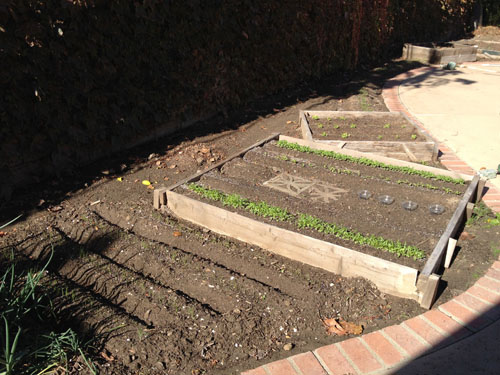
Unfortunately, this time around I didn't take many progress shots so now I present to you the current garden. Almost all the plants have sprouted with the exception of a few duds. My planter boxes were repaired and rearranged to capture more sunlight and provide better accessibility. The cinderblocks in the middle are so I can step in the box to work with the interior plants.
To the left of the box are red and yellow onions. In the big box from left to right are mizuna, dill/coriander, shiso, Swiss chard, and arugula. The box on the far right contains two rows of romaine lettuce and the last row is iceberg lettuce. Mizuna is a Japanese mustard and shiso is also known as perilla, a member of the mint family. I tried planting mitsuba, a type of Japanese parsely, but it didn't grow. Either the seeds are a dud or it germinates in warmer weather.
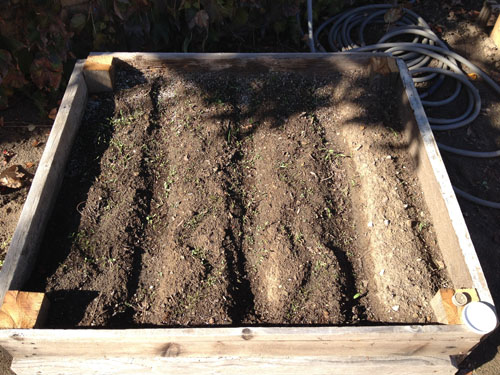
In this box I have carrots and celery. The two are actually related to each other, so I figured they should be able to grow in the same space.

The last two boxes contain the brassicas, a broad plant family which includes kale, cabbage, broccoli, cauliflower, and Brussels sprouts.
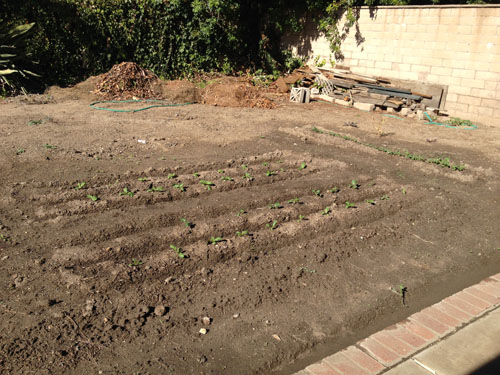
I tried to keep my winter garden small, but with the variety of things I wanted to grow I ended up expanding to another part of the yard. Over here we have the Asian cabbages, namely michihli, bok choy, and nappa. In the back are a single row of snap peas and snow peas.
When it comes to deciding where to grow each type of plant there are a number of factors that come into play, mostly unscientific. One of the first things I do is figure out where the worst growing spots are. In these areas I'll plant the hardiest, easiest growing plants I have. Onions and lettuces seem to fit the bill. Other consideration is based on experience. For example, I noticed during the summer the michihli grew extremely well in area I planted them in now. Maybe it's the sandy soil, ample sunlight, or soil texture. Who knows, as long as it grows well. There is also the issue of space and height. Taller plants shade smaller plants, and some plants don't mind being crowded while others do. I grouped the brassicas together in the two adjacent planter boxes because they all tend to grow tall and thus won't shade each other much. The cabbages I placed in the front facing the sun where they won't be overwhelmed down the road. Of course, these are only the basics, I won't get into detail about the smaller things. So much of garden design is preferential anyway.
When it comes to decided what to plant, that's easy. I try to grow everything I have. Well, kinda. I try to grow everything I can that can be grown in the current season. Plants where you eat the leaves like chard, lettuce, mustards, spinach, mints, and cabbages enjoy or at least tolerate cold weather. Other things that grow buds, bulbs, tubers, roots, or other planty things can be grown in wintertime. With the exception of the peas, most of the things I'm growing do not produce a specific "fruit" that can be picked from the plant. Winter plants are the ones where you eat a part of the plant itself, if that makes sense.
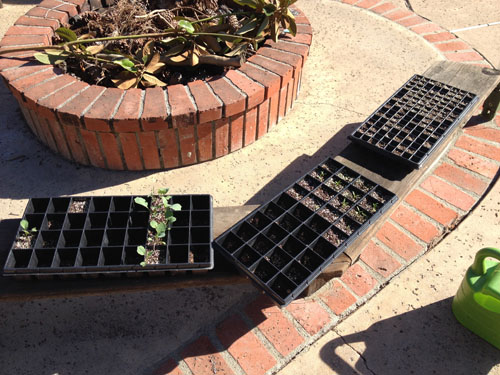
I'm still trying to get the planting process down with winter plants, mostly because they tend to grow from much smaller seeds when compared to things like beans or melons. This means the sprouts are much more fragile, and planting and watering them is a delicate affair. This year I started off many of the plants in trays. I direct sowed the plants that weren't so spacing dependent, which were the lettuces, onions, mizuna, chard, carrots, and arugula.
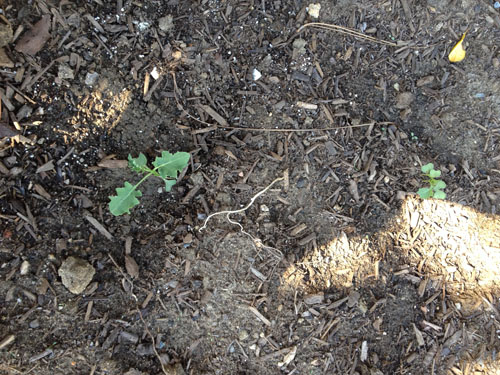
I've noticed a few things. On the right is kale I transplanted from the trays about two weeks ago. On the left is a kale plant from that same tray, except I left it in the tray for two extra weeks before putting it in the ground. The left one is visibly stronger, and lacks any kind of bite or chew mark. I believe this showcases the advantages of keeping plants in trays longer. The trays were able to be positioned to get more sun than the planter boxes, probably accounting for the larger leaves. Also, the lack of bite marks on the tray plants suggests that all my pests are land based and couldn't get to the sprouts in the trays. Next time I'll be sure to keep all my sprouts in the trays longer, but for how long before it stunts their growth I'm not sure.
I guess I'm caught up. That wasn't so bad. Now that the garden is in full swing and most of the hard work has been done, I'll have time to update the blog more often. There's always work to do and consequently always something to write about. Hmm... well... that's my mama!
|


































